For traditional theatre, particularly naturalism, the costume and properties allow the actors to embody their character: “Costume is one of the key transformative elements that help create the magic of theatre” (The Guardian, 2013). The scene may entail an intense conversation between two characters. One character’s responses are punctuated with sips from a wine glass – any director worth their salt would ensure that the wine glass is in hand early on in the rehearsal to ensure property handling is natural and not distracting for the actor. And as for the costume, Gary Oldman insists,
“Costume is so important for an actor. It absolutely helps to get into character; it’s the closest thing to you, it touches you. Some actors like to go into make-up and then put their clothes on, but I like to dress first; that’s my routine” (The Daily Telegraph, 2012).
Neither of these elements of theatre have been neglected in ‘Three Words’, however, the choice of costume is purposefully understated, and the props are not absolutely essential to the performance, but they add those little details to each scene.
Costume was discussed early in the process. Initially, the word ‘neutral’ was thrown around because so many of the scenes we were devising did not involve ‘acting’. We are trying to include and show a whole range of people. Therefore, we needed the costume not to distract or detract from what we are trying to translate to the audience. In terms of contemporary theatre, we are really performers, not actors.
Being is existence itself. “Doing” is the activity of all that exists, from quarks to sentient beings to supergalactic strings. “Showing doing” is performing: pointing to, underlining, and displaying doing. “Explaining ‘showing doing’” is performance studies (Schechner, 2002).
As Schechner describes, there are many forms in theatre. There are moments in the performance needs “Doing”, and this is contrasted to moments where we are “Showing doing” as a matter of steering away from representing. We are just the medium in which these stories can be relayed to an audience.
Later in the process we discussed costume again. We never steer away from showing our personalities in our Three Words, and therefore it no longer made sense to have a totally neutral costume. For this reason we came to the decision of wearing something that we would wear on an occasion, such as a romantic date. Of course, for practicality, it needed to be something that we could move freely in and that made us feel comfortable. Scott Graham, the artistic director of Frantic Assembly, describes the design of their costume as remaining naturalistic in their work, and does not have the same presence as it might in other companies (2013). This is the basic premise of how I advised the company to select their costume. Frantic Assembly is a physical theatre company, and therefore the main importance is that it does not restrict movement. For ‘Three Words’, the main note I gave was that they should chose something that they would not fiddle with or have to fix throughout the performance, as we are all constantly on stage. But also remained naturalistic to our world of theatre. I suppose the ambiguous smart/casual is the best way of describing it!
The importance (and number) of props have accumulated throughout the rehearsal process. We have a lot of items that are real things of sentimental value from our own relationships, or things we have borrowed from other people’s relationships, that are attached to a washing line at the back of the stage. It acts as a time-line of a relationship. It is also to highlight the human tendency to be sentimental with the little things in relationships that are totally personal and unique. It’s not just about jewellery and flowers, but hand written letters and koala shaped purses.
There are other properties that essentially add detail to the scenes, for example, I made a tiny veil and bow tie for our artist’s mannequins in ‘The Wedding Scene’.
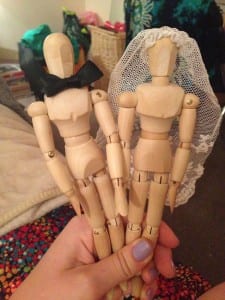
It is these elements that we thought were really important to make the effort to do and make, as it shows attention to detail and ties into the tone of the piece – where some things are just a little silly! In addition, the majority of these details I hand-made to show they had come from personally from us. Again, it shows care and effort. Although in some productions, shiny machine made properties make the production appear highly professional, for us it was all about showing humanity and being approachable. For example, two sheets are hung from the washing line at the beginning off the show, saying ‘Three Words’. This was hand painted with intentionally patchy green paint. This echoes the potato-print style font of our posters and flyers, but also because its not perfectly painted, or professionally printed, it really underscores the personal nature of the piece.
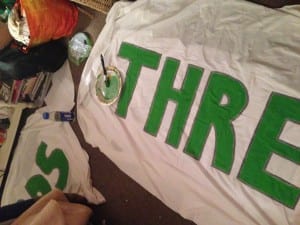
We are also careful to ensure that the majority of the properties we use are used again in another scene. For example, we have transformed two ordinary men’s jackets into puppets by carefully making holes down the seam of the elbows and shoulders, so that our puppeteers can use their arms through the sleeves and bring the jacket ‘to life’, using an upside-down coat hanger for structure. I then stitched shoulder pads to build up the structure and create a more human silhouette.
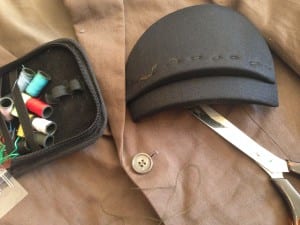
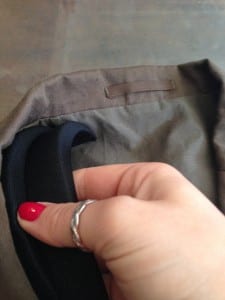
These are used to enact the story of two men in love. We use the same jackets when re-enacting the final scene of Brief Encounter (1945). This is one of the few occasions where costume was necessary to show we are not ourselves. The two men’s jackets in this section also evoke the possibility that Brief Encounter was actually about a homosexual relationship. Again, these are things that can be read into as little or as much as the audience wishes.
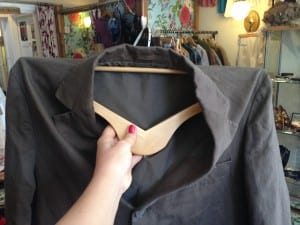
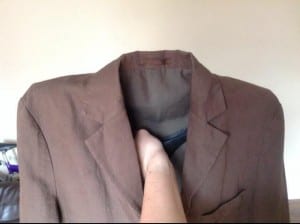
Properties and costume really are the finishing touches to what will hopefully be a successful and entertaining show. They create these details that we feel confident in adding to the performance without hindering our slickness (or organised chaos!). It adds hand-made sentiment to a stage laden with cables and microphones.
Works Cited
Graham, S. (2013) Frantic Assembly Forum: Costume Design. [online] London: Frantic Assembly. Available from: http://www.franticassembly.co.uk/forum/topic/55/ [Accessed 24 May 2014]
Howarth, P. (2012) Gary Oldman interview: Dressing the part. [online] London: The Daily Telegraph. Available from: http://fashion.telegraph.co.uk/news-features/TMG9188999/Gary-Oldman-interview-Dressing-the-part.html [Accessed 24 May 2014]
Schechner, R. (2002) Performance Studies: An Introduction. Routledge: Abingdon.
The Guardian (2013) Costume Design for Theatre with Tom Piper. [online] London: The Guardian. Available from: http://www.theguardian.com/guardian-masterclasses/costume-design-tom-piper-theatre-course [Accessed 24 May 2014].